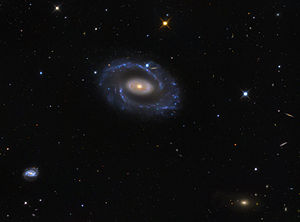NGC 210
| Galaxy NGC 210 |
|
|---|---|

|
|
| Image in the visible spectral range with the 32-inch telescope at Mt. Lemmon SkyCenter (lower left MCG-02-02-082 ) | |
| AladinLite | |
| Constellation | whale |
|
Position equinox : J2000.0 , epoch : J2000.0 |
|
| Right ascension | 00 h 40 m 35.0 s |
| declination | -13 ° 52 ′ 22 ″ |
| Appearance | |
| Morphological type | SAB (s) b |
| Brightness (visual) | 10.9 likes |
| Brightness (B-band) | 11.7 mag |
| Angular expansion | 5 ′, 0 × 3 ′, 3 |
| Position angle | 160 ° |
| Surface brightness | 13.8 mag / arcmin² |
| Physical data | |
| Redshift | 0.005457 ± 0.000010 |
| Radial velocity | 1636 ± 3 km / s |
|
Stroke distance v rad / H 0 |
(75 ± 5) x 10 6 ly (23.0 ± 1.6) Mpc |
| history | |
| discovery | Wilhelm Herschel |
| Discovery date | October 3, 1785 |
| Catalog names | |
| NGC 210 • PGC 2437 • MCG -02-02-081 • IRAS 00380-1408 • 2MASX J00403502-1352220 • GC 107 • H II 452 • h 46 • HIPASS J0040-13 • LDCE 0041 NED002 | |
NGC 210 is a bar-spiral galaxy of the Hubble type SBb in the constellation Whale south of the celestial equator . It is estimated to be 75 million light years away from the Milky Way and has a disk diameter of around 110,000 ly.
The supernova SN 1954R was observed here.
The object was discovered on October 3, 1785 by the German-British astronomer Wilhelm Herschel .
Web links
Commons : NGC 210 - collection of images, videos, and audio files
- Capella Observatory
- Spektrum.de : Amateur recordings [1]
- SIMBAD Astronomical Database
